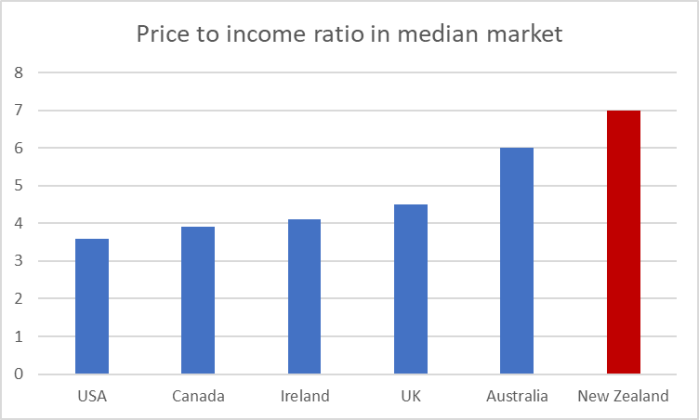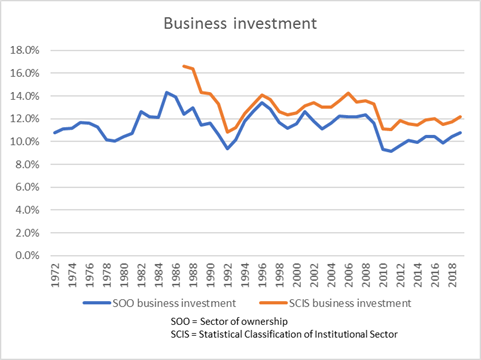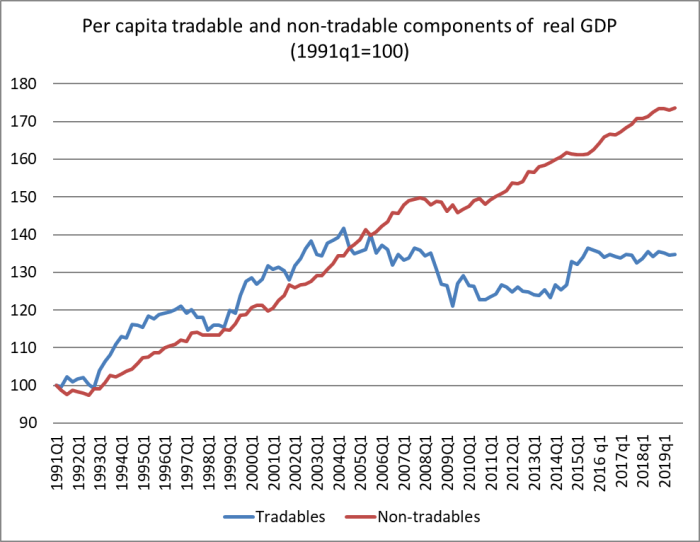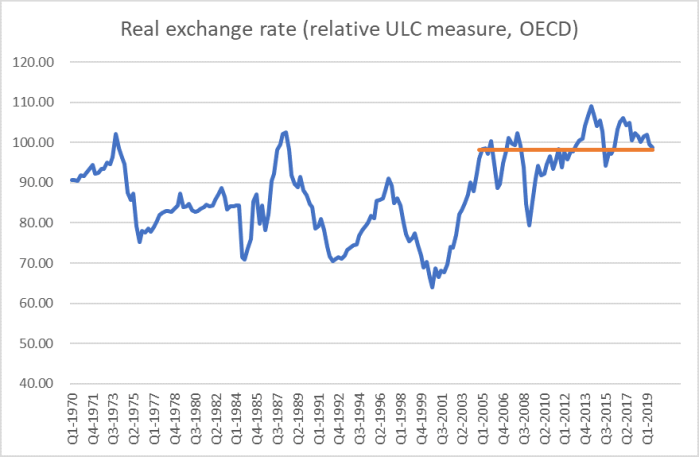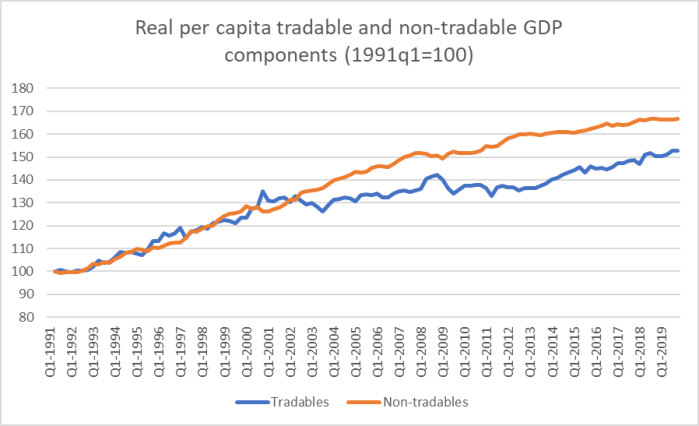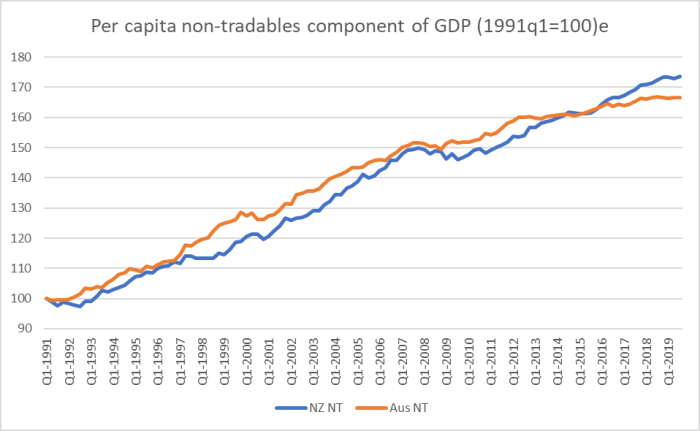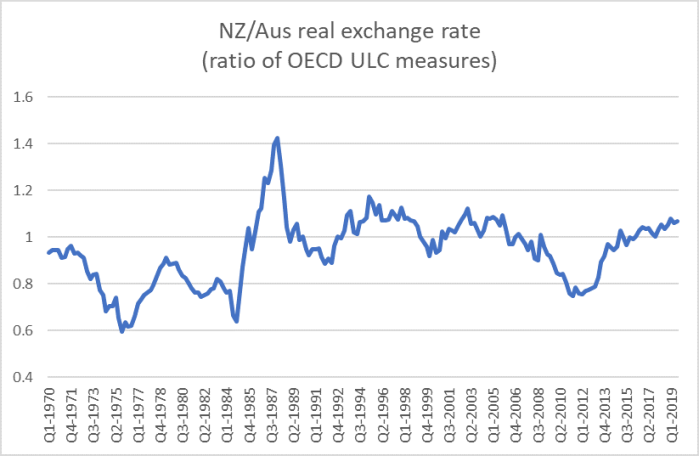Presumably someone pointed the Retirement Commissioner to my post yesterday ,as I gather the online version of the triennial report now has a “Foreword”, rather than the “Forward” that appeared until yesterday. We all make mistakes, typos, and literals, but you’d suppose that well-funded government agencies would have prominent parts of high-profile documents proofread. Anyway, enough of that (perhaps rather petty) point.
One other aspect of the Commissioner’s report that caught my eye was the bit about “ethical investment”. This was prompted by the government, which had asked the Commissioner to report on
Information about the public’s perception and understanding of ethical investments
in KiwiSaver, including:
a) The kinds of investments that New Zealanders may want to see excluded
by KiwiSaver providers; and
b) The range of KiwiSaver funds with an ethical investment mandate.
As I noted yesterday, there is a make-work element to the Commissioner’s role (and his supporting office, the so-called Commission for Financial Capability). You might have supposed that firms operating Kiwisaver schemes, or attempting to sell their products to managers of Kiwisaver funds, might be best placed to work out what, if any, investments “New Zealanders” didn’t want to invest in. It is a (potential) marketing opportunity, and one the providers are strongly-incentivised to tap. They also get to experiment, and see which products actually attract (or turn off) savers – revealed preference often being quite different than (say) idle costless, perhaps even virtue-signalling, response to surveys.
Strangely, the Retirement Commissioner starts this section of the report by mischaracterising the terms of reference
In term of reference five, the Government asked us to provide information about the public’s perception and understanding of ethical investment.
Except that (see above) that wasn’t what was asked for at all.
Anyway, they commissioned a report from consultants at KPMG. KPMG appear not to like the notion of “ethical” investment, and prefer “responsible investment” instead. I guess if you poll people and ask if they want “responsible investment” you’ll probably get 100 per cent saying yes. It all rapidly becomes rather empty – your “responsible” is, often enough, my “deeply corrosive”, and vice versa. You can read the KPMG report and all the discussion of how funds can/do try to take account of ESG (environmental, social, governance) considerations. But there isn’t really much there – in my observation (as trustee of a couple of funds) much of it is marketing hype. Perhaps the one bit of the KPMG report that caught my eye.

The key sentence is that one just above the table. It (and the data in the table) do not make into the Retirement Commissioner’s report.
The Retirement Commissioner’s report then moves on to public opinion noting that
In addition to the KPMG work, CFFC includes ethical investment in its own regular surveys of the public.
There is a footnote there to this internal note, but unfortunately there is no link to the full results of the poll, including either the exact wording of the questions or the respondent comments (selected ones of which are quoted in the report, but with no way to judge how representative these observations are).
They are keen to talk up the results
From this, we know that ethical investment is important to the majority of
respondents, with only 26% of overall respondents, and 18% of contributing KiwiSaver members, stating that they are NOT interested in ethical investment.
Actually, I was little surprised that 18 per cent of respondents were prepared to tell a survey taker that they had no interest in an ethical approach to their investments. But just saying it just doesn’t mean much.
Anyway, this was the main table on specific types of industries (although it isn’t clear whether respondents were prompted – I’m guessing so – with this particular list, or whether everyone came up with their own preferences).

The Commissioner writes about this table thus
We also know that:
• In terms of which investment most want excluded from investments, animal cruelty, worker exploitation, whaling and pornography top the list, with over 70% of
respondents agreeing these are exclusion priorities.
But without knowing the precise wording of the question, we can’t even be sure that is right. The Commissioner seems to interpret the results as meaning people don’t want to invest in these industries, but the description in the table suggests the question might have along the lines of “if there were an “ethical investment fund which industries should be excluded”. They are two quite different things, as revealed preference seems to confirm. It is, for example, hard to believe that 43 per cent of New Zealanders really don’t want beer or wine company shares in their Kiwisaver investment – it not being 1918, and the near vote for Prohibition, actual teetollars being probably no more than 20 per cent of the population. But perhaps they think it is what an “ethical investment fund” might exclude? And since parties supporting disbanding the military are notable by their absence, one might also be a little sceptical about what people actually had in mind – feel-goodness apart – in their weapons answers.
(There is some interesting demographic data, notably that in all the categories above women were more likely to favour exclusion than men.)
Then it starts to get a bit awkward
A majority of respondents are satisfied with available ethical investment options within KiwiSaver and of those contributing, 70% are satisfied with the range of ethical investment options.
This high level of satisfaction is a surprise because most ethical investment funds do
not meet the expectations reported by survey participants.
But perhaps not so much, because in the internal research note – but not in the published report – we find this
However, only a minority selected ethical investment when asked about the criteria for selecting a fund. A possible explanation is that respondents show social desirability bias (select the “right” answer) when asked about ethical investment directly, but their actual behaviour shows limited consideration of ethical investment in KiwiSaver funds.
Revealed preference seems to be that the public don’t really care much at all (and/or, it might be hard/costly to evaluate funds for your own preferences).
But despite all this, the one recommendation in this section of the report is
PUBLICLY FUND MINDFUL MONEY TO ERASE ANY POTENTIAL CONFLICTS
OF INTEREST: INTRODUCE TAXPAYER FUNDING FOR MINDFUL MONEY TO GUARANTEE THE CHARITY CONTINUES TO PUBLISH UNBIASED, RESPONSIBLE INVESTMENT INFORMATION.
Of Mindful Money
Mindful Money is a charity that promotes ethical investment, and was recently
launched (September 2019) in response to the public demand for more knowledge
and options to invest ethically. Mindful Money’s mission statement is to: ‘empower
investors and make investment a force for good. Over the next five years we aim to
switch $6 billion of investment funds away from pollution, exploitation and inequality towards a low emissions, sustainable and inclusive economy.’
It is run by someone who was a Green Party MP until the last election.
So, the public show little practical sign of caring very much, civil society has set up its own entity (which has managed to attract some commissions for referrals) and yet one well-funded government agency’s proposal is that yet more public money should be pushed in the direction of this charity.
As they recognise, simply funnelling money to one brand-new private charity would be unusual
While conscious that the regular process would be to go to tender first, we think in
terms of efficiency and cost, and considering that the public want information now so that they can make informed choices that align with their personal values, funding Mindful Money is the most efficient and simple step for the Government to take.
Oh well, never mind about good process, or whether Mindful Money might just be channelling a particular subset of distastes….toss them some public money. Barry Coates must have welcomed the report.
As I noted at the start, the Retirement Commissioner was landed with this particular term of reference, so they had to write something. But how they responded was up to them, and it simply wasn’t particular thoughtful or rigorous, more about how do we get on the bandwagon.
In truth, ethical investment is hard, and something of challenge to each of us as to how much we care about particular issues. Personally, if I were buying company shares directly, I would refuse to purchase companies operating in the small handful of the sectors listed in the CFFC table above (gambling, pornography, and – depending on definition – animal cruelty). But there are plenty of other activites I would also refuse to invest in (including hospital companies providing abortions, any PRC company, companies that actively facilitate the interests of the worst regimes on the planet – including the PRC). That is easy to say, and actually fairly easy to do.
But once you get into collective investment vehicles – where the diversification gains and low transactions costs (and even PIE tax rates) are very real advantages – it quickly becomes very difficult. For example, much of my retirement savings is in a scheme I joined – as a manadatory condition of service – almost 40 years ago. My ethical views aren’t necessarily those of other members, and even though I’m a trustee of the scheme I have legal constraints on my ability to make what seem like ethical choices to me (and that is probably as it should be). I’d find it all but impossible to find a Kiwisaver vehicle offering my list of exclusions – and, on the other hand, I’m very happy to have an interest in shares in arms companies, oil companies etc – and so, in practice, I do not do anything about the issue. I’m a trustee of another pension fund – where there might actually be some commonality of ethical preferences among members – but even then it is difficult to get members to reveal those preferences consistently and (again) legal constraints.
But all of these issues are yet another reason why I favour winding up the New Zealand Superannuation Fund. Holding a particular Kiwisaver fund is strictly voluntary (you might not find an ideal fund, but there is quite a bit of choice), but your exposure or mine to the assets held in the New Zealand Superannuation is inescapable. They like to boast about what “responsible” investors they are, but all that really tells you is that they line up with the personal political/ethical preferences of Matt Whineray and his Board (or Adrian Orr before that). We simply should not have money coercively taken from us and invested in causes and companies we individually find distasteful, even reprehensible. That is true whether your burning concern (so to speak) is fossil fuels, pornography, marijuana, abortion, the whales, or whatever. There is no compelling public policy case for the fund, and the way its investment policy trespasses – ignores – the ethical preferences of many citizens simply further undermines that case.
Some thoughtful discussion of issues like that might usefully have found a place in the Retirement Commissioner’s report. It didn’t of course. Some hardheaded analysis of just how much people really valued “ethical investing” might have made it into the report. But it didn’t either.
It was a pretty disappointing report all round.





